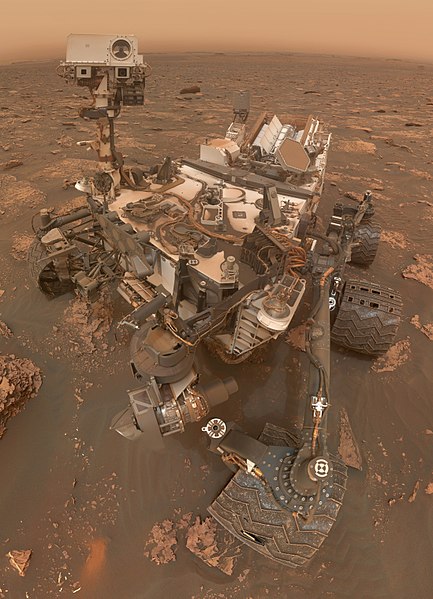File:NASA-CuriosityRover-Selfie-June2018.jpg

Original file (4,392 × 6,066 pixels, file size: 3.63 MB, MIME type: image/jpeg)
This file is from Wikimedia Commons and may be used by other projects. The description on its file description page there is shown below.
Summary
| DescriptionNASA-CuriosityRover-Selfie-June2018.jpg |
English: NASA's Curiosity rover takes stunning selfie during massive dust storm on Mars[1]
https://www.flickr.com/photos/seandoran/42803757572/ But first, let me take a selfie. NASA's Curiosity rover has taken an incredible selfie image during an "unprecedented" massive dust storm on Mars. The image, a composite created by scientist Seán Doran, who works with NASA'S Jet Propulsion Lab to create and process its photography, shows the $2.5 billion research vehicle stylin' and profilin' in the wake of the epic dust storm happening on the Red Planet. "It's blended out of the shot," Doran told the Daily Mail when asked how he created the image. "The arm moves around as it takes about 100 images to make a full 360 (degree image)." The Curiosity rover is currently on the Gale Crater on Mars, a 96-mile-wide valley that researchers once believed housed a giant lake. The dust storm has wreaked havoc on Mars, with NASA holding a press conference last week to give an update on how it is affecting its operations on Mars. Luckily, the Curiosity rover is able to function, as it relies on plutonium and not sunlight as a fuel source. However, the Opportunity rover, which has been on Mars for nearly 15 years, has not been so lucky, effectively going into sleep mode during the storm. "The storm is one of the most intense ever observed on the Red Planet," NASA said in a statement last week. "As of June 10, it covered more than 15.8 million square miles (41 million square kilometers) – about the area of North America and Russia combined. It has blocked out so much sunlight, it has effectively turned day into night for Opportunity, which is located near the center of the storm, inside Mars' Perseverance Valley." Aside from its photogenic prowess, the Curiosity rover made global headlines earlier this month when NASA announced that it had found organic molecules on Mars, providing fresh insight into the Red Planet. “We found organic molecules in rocks from an ancient lake bed,” explained Jen Eigenbrode, research scientist at Goddard. A variety of molecules were identified, she added. The rocks are billions of years old, according to NASA. While NASA was at pains to explain that it has not discovered life on Mars, the organic molecules could provide vital clues. “Organic compounds are fundamental to our search for life,” said Paul Mahaffy, director of the Solar System Exploration Division at Goddard. Described as the most technologically advanced rover ever built, Curiosity launched on Nov. 26, 2011. The rover landed on Mars' Gale Crate on Aug. 6, 2012, with the goal of determining whether Mars was ever able to support microbial life. The rover has already delivered other important scientific results. In 2013, analysis of a rock sample collected by the vehicle showed that ancient Mars could have supported living microbes. In 2014, the rover measured a tenfold spike in methane, an organic chemical, in the atmosphere around it. At that time, the robotic laboratory also detected other organic molecules in a rock-powder sample collected by its drill. In December 2017, NASA announced that it was building a new rover to look for life on Mars, dubbed Mars 2020. References
|
| Date | Taken on 15 June 2018 |
| Source | https://www.flickr.com/photos/seandoran/42803757572/ |
| Author | NASA / JPL-Caltech / MSSS / Seán Doran |
Licensing
| Public domainPublic domainfalsefalse |
| This file is in the public domain in the United States because it was solely created by NASA. NASA copyright policy states that "NASA material is not protected by copyright unless noted". (See Template:PD-USGov, NASA copyright policy page or JPL Image Use Policy.) |  | |
 |
Warnings:
|
Captions
Items portrayed in this file
depicts
15 June 2018
File history
Click on a date/time to view the file as it appeared at that time.
| Date/Time | Thumbnail | Dimensions | User | Comment | |
|---|---|---|---|---|---|
| current | 16:52, 18 June 2018 |  | 4,392 × 6,066 (3.63 MB) | wikimediacommons>Drbogdan | cropped version |
File usage
The following page uses this file:
Global file usage
The following other wikis use this file:
- Usage on miraheze.org
